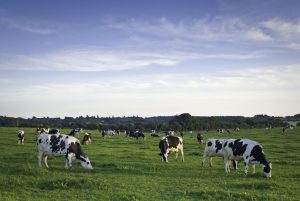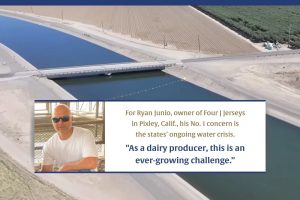
The state leads the nation in beef cattle. But dairy has been on the rise for several years now, and the industry appears poised to keep growing. Texas recently passed Idaho to become the third-largest milk producing state in the U.S. Darren Turley, executive director of the Texas Association of Dairymen, spoke to Texas Standard about what’s behind the growth. Listen to the interview above or read the transcript below.
This transcript has been edited lightly for clarity:
Texas Standard: What’s behind all this growth in the Texas dairy industry? It’s my understanding that if you look at the top five, Texas has surpassed New York and Idaho more recently, right?
Darren Turley: Yes, sir. We have worked diligently for about a year and a half, two years to kind of overtake New York. That was a big accomplishment. And then surprisingly, the first of this year, we’ve surpassed Idaho as well. We’ll see if we can continue that throughout the year. But right now, we are surpassing them.
Holy cow. Well, is this growth from brand new dairies or dairies from out of state moving here or existing dairies increasing the size of their operations?
We really haven’t had new dairies come to the state now in several years. And so we’re really seeing a continued growth of better genetics and management. And we’ve had a couple of mild years. I know we’ve had a cold snap in there, but in general the last couple of years have been pretty mild weather and those mild summer are sure to help milk production for dairy cows.
It’s funny because it almost seems counterintuitive. We’ve been reading and hearing so many stories about Texas becoming hotter and drier, what with climate change. It struck me as somewhat counterintuitive when I read this story that Texas had moved into the number three slot.
Well, it is, but the dairy industry is up in the northern part [of the state]. Now 82% comes out of the panhandle of the state. And cows don’t really like humidity. Cows don’t really like wet weather. And so these factors are a plus for the dairy industry. Now, making crops and feeding the cattle is a challenge in dry weather, but milk production usually works very well.
Let me ask you about what that does, if anything, to the milk itself. Does climate affect anything about the product? Is there something about raising dairy cows in Texas versus a place like Wisconsin, that could affect the product?
No, not really. Most of the products are homogenized to be the same. And so there’s very little impact. There would be a slight change in what we feed the cattle. But the way we feed cattle is so scientific that we just balance the ingredients, basically back to amino acid levels, not even just protein and carbohydrates. So that’s usually not too big of an impact.
Has the industry actually been making a push in Texas to grow the dairy industry, or is this something that’s just sort of organically occurred as people were looking for new ways to grow their agricultural investments?
Well, Texas had seen some growth a decade ago. We had some California dairies that had moved in and they have now matured. And production is doing well. As far as the industry goes, the big news for the dairy industry is we do have some new plants in place that are going to be breaking ground, building construction in the next few years and will give us the ability to grow even further. In two to three years from now, we should see another pretty good growth. I don’t know that we we’re big enough to take Wisconsin for number two position, but we will continue to mature and produce more milk in Texas.
Tell us a little bit about the investments being made. Where’s the money coming from to build these plants, as you’re describing?
We have a California-based Hispanic cheese production facility. Cacique Cheese is coming from California to make their first expansion is going to be in the Amarillo area. We also have a Leprino cheese plant, which is going to be quite large outside of Lubbock that has just been announced as well. So those two facilities will give us roughly another 200 loads of milk of processing capacity. So 200 more truckloads a day of milk eventually will be made in Texas to fill those plants.
I’m no cheese connoisseur, but. But I wonder. Do you think Texas cheese could make a mark in the industry?
It is more and more. Most people are eating a lot of Texas cheese, whether they know it or not. It’s been labeled and a lot of fast food cheeses [are from Texas]. So Texas is continuing to grow. We also see the location of Texas with the port and then, of course, our southern neighbors is being a bigger factor for export. Right now, almost one in every five milk trucks is going to export. And so we continue to grow that market as well. And so for Texas and its location, that’s a benefit to us in the future.























